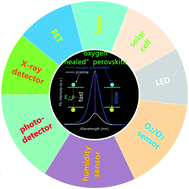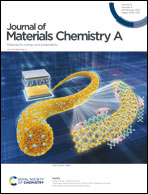Oxygen-induced defect-healing and photo-brightening of halide perovskite semiconductors: science and application†
Abstract
Solution-processed metal halide perovskite (MHP) semiconductors have shown remarkable success in diverse optoelectronic device applications, especially in solar cells, despite having a non-negligible density of defect states. The photoluminescence quantum yield (PLQY) is usually taken as a proxy to evaluate the optoelectronic quality of MHPs. Higher PLQYs imply a reduction of nonradiative deactivation pathways, which can contribute to a lower nonradiative voltage loss and higher open circuit voltage of the final device. Many studies have reported various methods to passivate the defect states in MHPs and to enhance their PLQYs. An interesting observation that has been repeatedly reported recently is a drastic PLQY enhancement upon exposure of MHPs to dry air or oxygen under illumination, which is the so-called photo-brightening phenomenon associated with oxygen-induced defect-healing (OIDH) of MHPs. This phenomenon involves the interaction between oxygen and defects in MHPs, as the adsorption and diffusion of oxygen can mediate the perovskite lattice and passivate the defects (such as halogen vacancies and interstitials, halogen migration and aggregation) on the surface or in the bulk of MHPs. In this review, we mainly focus on the recent advances and the related sciences in enhancing the optoelectronic quality of emerging MHP semiconductors by effective defect passivation though a facile oxygen post-treatment, which is the so called OIDH effect and the associated photo-brightening effect, as well as their wide applications in solar cells, LEDs, oxygen/ozone sensors, X-ray detectors, etc. Our work highlights the great potential of the efficient and convenient in situ defect passivation of emerging MHP semiconductors by oxygen (abundant in an ambient atmosphere) towards various perovskite based optoelectronic applications.

- This article is part of the themed collection: Editor’s Choice: Perovskite-based solar cells


 Please wait while we load your content...
Please wait while we load your content...